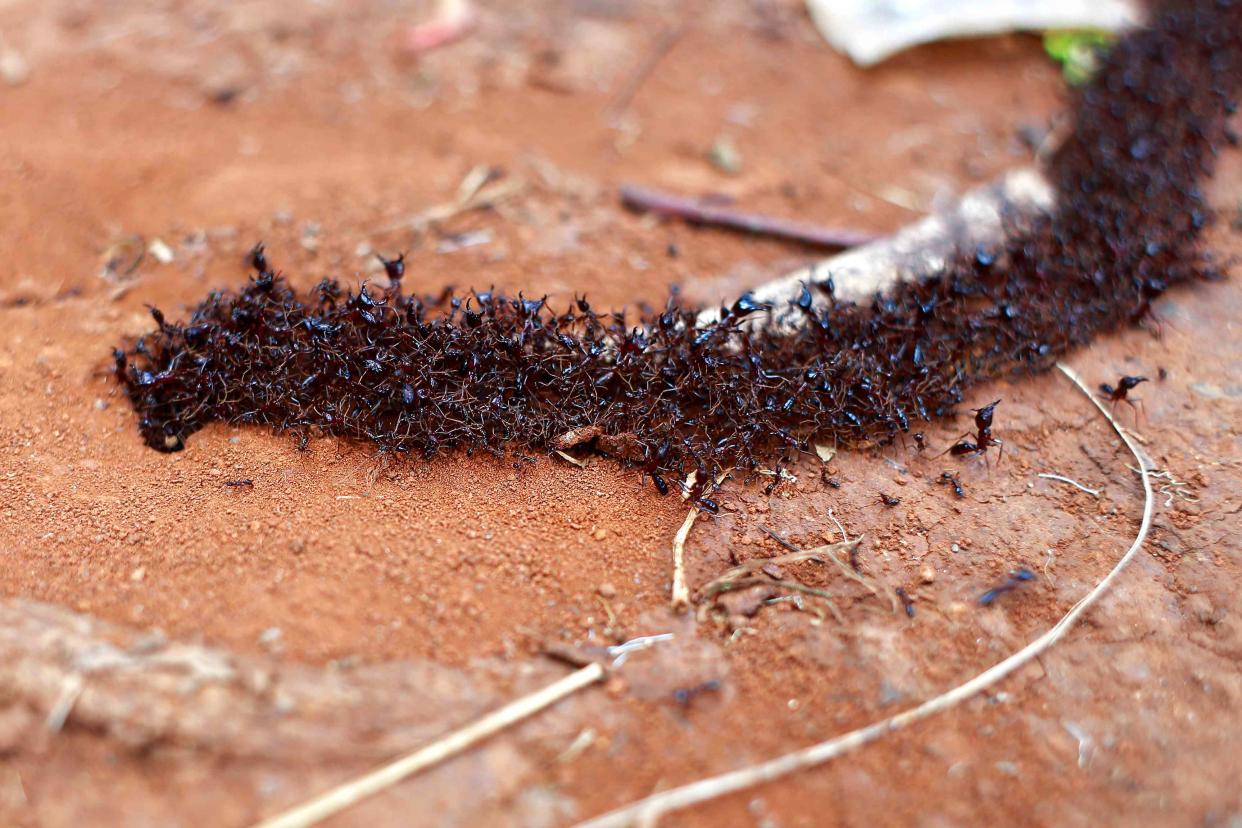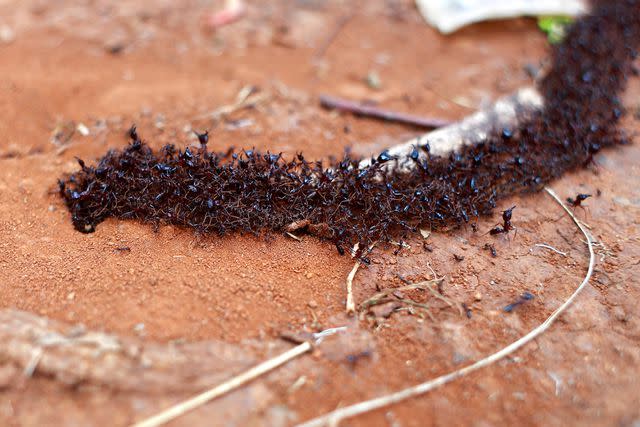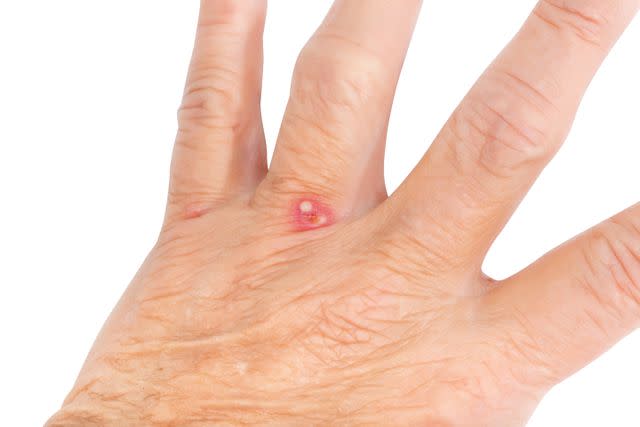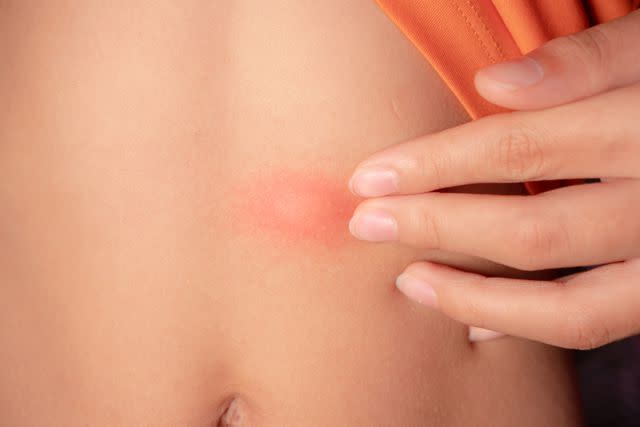How to Treat Itchy, Painful Ant Bites

Leonardo Monteverde / Getty Images
Medically reviewed by Sameena Zahoor, MD
There are several types of ants in the United States that sting or bite, including fire ants, harvester ants, carpenter ants, and field ants. What is commonly referred to as ant bites are actually ant stings.
After an ant sting, you’ll most likely experience an initial burning or itching sensation. Then, you'll likely have pain, redness, and/or swelling in the area of the sting for a few hours. More serious reactions, including allergies, are rare.
This article will go over the types of ants that sting, as well as common home remedies and treatments that can offer relief.

Leonardo Monteverde / Getty Images
Ant Bite Pictures: What Do They Look Like?
Ant bites or stings usually cause localized swelling and redness. The affected area of the skin is typically less than 2 inches in diameter. You may have just one welt or several, depending on how many ants have stung you.
Within around half an hour, you’ll develop hives (urticaria) or hive-like bumps with raised centers, followed by pimple-like pustules after about 24 hours.
Alongside redness and swelling, common ant bite symptoms include:
Sharp, stinging pain (usually for less than 10 minutes)
An immediate burning sensation just after the bite or sting
Itching for up to several weeks
Skin that is warm or hot to the touch
Pictures of ant bite reactions appear below.

JodiJacobson / Getty Images

amnat jomjun / Getty Images
Types of Ants That Bite vs. Sting
There are over 12,000 species of ants around the world. In the United States, the types of ants that are most likely to bite or sting you include:
Fire ants: Common to the southern United States, fire ants are known as especially aggressive to humans. These bright red, venomous insects typically sting around seven to eight times in a circular pattern. Their stings cause pinching, burning pain that eventually turns into intense itching.
Harvester ants: Harvester ants thrive in bare soil in California and states west of the Mississippi River, as well as just Florida on the East Coast. These ants may be brown, red, or black. Like fire ants, harvester ants are venomous and carry a painful sting.
Carpenter ants: Carpenter ants, also known as oak ants, make their homes by burrowing smooth tunnels into wood. Typically black, red, or brown, this ant species is often found inside homes in the northern United States. Carpenter ants can bite hard enough to break the skin, but they usually don’t cause allergic reactions.
Field ants: Field ants build their mounds outdoors, often in open fields. There are many different species of field ants, which can be black or red. They may bite humans, dogs, or cats if disturbed. However, their bites are usually harmless and cause no more than a brief pinching sensation.
Home Remedies and Treatment for Mild Ant Bites
Just after an ant bite or sting, follow the steps below to lower your risk of an adverse reaction:
Quickly remove any remaining ants from your skin.
Remove jewelry from the affected areas (such as rings, if you were bitten on the hand).
Wash the affected skin with soap and water, not alcohol.
If you were bitten on the face, rinse your eyes out with water.
Wrap ice in a washcloth to create a cold compress.
Apply the cloth to the sting site for 10 minutes at a time, with 10-minute breaks in between.
Should You Pop Ant Bites?
It might be tempting to pop your blisters after an ant bite, but it’s important to leave them alone. Opening them up could lead to infection.
Ant Bite Healing: How Long Could Bites Last?
The typical cycle of an ant bite usually follows this timeline:
After 10 minutes: Initially, an ant bite causes burning or pinching pain, followed by a sting at the site of the bite. This usually lasts for up to 10 minutes.
After four to six hours: Within 30 minutes, most people develop swelling and redness at the sting site. The swelling can last for up to six hours.
After 24 hours: After around a day, your hives may fill with yellow pus. This is especially common after fire ant stings.
After three to 10 days: The pustules should open up, crust over, and form scabs within three to 10 days.
After several weeks: You may continue to experience itching at the sting(s) site for a few weeks.
More serious reactions to ant stings may take longer to clear up.
Signs of a More Serious Ant Bite
Most ant bites aren’t serious and go away independently within a few hours, days, or weeks. You may need to talk to a healthcare provider if your swelling doesn’t go away or if it affects your mobility, that is, if you were stung on the feet or hands. Steroids may be prescribed to offer relief.
Although rare, some people experience systemic, or generalized, reactions after being stung by an ant. This means their symptoms spread throughout their body rather than being limited to the sting area.
Signs of a more serious reaction to an ant bite may include:
Skin flushing
Severe itching
Swelling in areas of the skin that weren’t stung
Nausea
Diarrhea
Mild abdominal cramping
Dizziness
Get medical help right away if you develop any of these symptoms.
In very rare cases, you may experience a severe allergic reaction (anaphylaxis) after an ant bite. Usually, this happens about 30–40 minutes after the sting. Signs of anaphylaxis include:
Vomiting
Difficulty breathing
Swelling of the throat, tongue, or lips
Chest pain
Low blood pressure
Muscle weakness
Rapid heart rate
If you develop any of the above symptoms, seek emergency help immediately. Anaphylaxis can be life-threatening. Call 911 or go to your local emergency room for treatment.
Caring for Painful Ant Bites
For itchy, painful ant bites, treatment options include:
To relieve itching and swelling, take an over-the-counter (OTC) antihistamine or apply topical corticosteroids, such as hydrocortisone.
For mild to moderate pain, OTC pain relief medicines, such as Advil or Motrin (ibuprofen), can help.
In more serious cases, your healthcare provider may prescribe an oral corticosteroid, such as prednisone, and/or steroid creams.
For systemic reactions, an allergist may prescribe antihistamine injections or immunotherapy.
How to Avoid Ant Bites
The best way to prevent ant bites in the future is to avoid the environments they’re most likely to inhabit. Talk to a pest control specialist about removing ant nests from your home or yard. It’s also a good idea to wear socks, shoes, and long-sleeved shirts when you’re outside whenever possible. Wear gloves if you garden frequently or work outside. Spray areas where ants are likely to congregate with insecticides.
Summary
Ant bites and stings usually aren’t a reason for serious concern, but they can be itchy and painful. Over-the-counter pain relief medications and corticosteroids can relieve some of your symptoms.
Get medical help as soon as possible if your symptoms worsen or spread to other parts of your body. If you notice any signs of a serious allergic reaction—such as shortness of breath, throat swelling, or a racing heart—seek emergency medical treatment right away.

